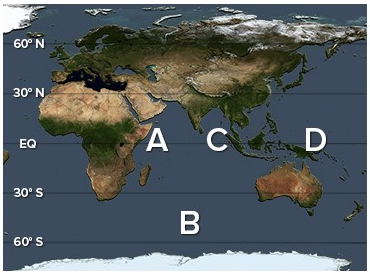Most energy entering the earth's atmosphere is between ________ and ________ microns while most of the thermal infrared energy emitted from the earth is between ________ and ________ microns
A) 20; 40; 40; 60
B) 8; 13; 20; 40
C) 0.1; 0.4; 8; 13
D) 0.4; 0.7; 8; 20
D) 0.4; 0.7; 8; 20
You might also like to view...
A positive phase of the Indian Ocean Dipole (IOD) results in warmer than average surface waters at ________ and cooler than average waters at ________.

A) A; C
B) A; D
C) C; A
D) C; B
The change of water vapor to a liquid is called
A) evaporation. B) condensation. C) saturation. D) dew point.
Particulate pollution can affect the intensity of the urban heat island via
A) their release of latent heat. B) their effect on the radiation balance. C) their transparency to both shortwave and longwave radiation. D) their ability to store heat.
Which one of the following actions by scientists is least applicable to the field of environmental science?
A) Scientists determine the best fuel to generate electricity for a growing city in Arizona. B) Scientists help a rancher determine the best ways to rotate herds of cattle to reduce erosion. C) Scientists study X-ray emissions for evidence of black holes. D) Scientists at NASA launch satellites to monitor changes in carbon dioxide production on Earth.